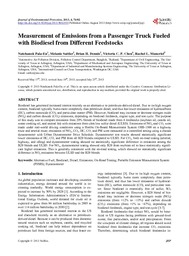| dc.contributor.author | Pala-En, Natchanok | |
| dc.contributor.author | Sattler, Melanie L. | |
| dc.contributor.author | Dennis, Brian | |
| dc.contributor.author | Chen, Victoria | |
| dc.contributor.author | Muncrief, Rachel L. | |
| dc.date.accessioned | 2016-12-14T02:19:35Z | |
| dc.date.available | 2016-12-14T02:19:35Z | |
| dc.date.issued | 2013-08 | |
| dc.identifier.citation | Published in the Journal of Environmental Protection 4: 74-82, 2013 | en_US |
| dc.identifier.uri | http://hdl.handle.net/10106/26311 | |
| dc.description.abstract | Biodiesel has generated increased interest recently as an alternative to petroleum-derived diesel. Due to its high oxygen
content, biodiesel typically burns more completely than petroleum diesel, and thus has lower emissions of hydrocarbons
(HC), carbon monoxide (CO), and particulate matter (PM). However, biodiesel may increase or decrease nitrogen oxide
(NOx) and carbon dioxide (CO2) emissions, depending on biodiesel feedstock, engine type, and test cycle. The purpose
of this study was to compare emissions from 20% blends of biodiesel made from 4 feedstocks (soybean oil, canola oil,
waste cooking oil, and animal fat) with emissions from ultra low sulfur diesel (ULSD). Emissions of NOx and CO2 were
made under real-world driving conditions using a Horiba On-Board Measurement System OBS-1300 on a highway
route and arterial route; emissions of NOx, CO2, HC, CO, and PM were measured in a controlled setting using a chassis
dynamometer with Urban Dynamometer Drive Schedule. Dynamometer test results showed statistically significant
lower emissions of HC, CO, and PM from all B20 blends compared to ULSD. For CO2, both on-road testing (arterial,
highway, and idling) and dynamometer testing showed no statistically significant difference in emissions among the
B20 blends and ULSD. For NOx, dynamometer testing showed only B20 from soybean oil to have statistically significant higher emissions. This is generally consistent with the on-road testing, which showed no statistically significant
difference in NOx emissions between ULSD and the B20 blends. | |
| dc.description.abstract | Biodiesel has generated increased interest recently as an alternative to petroleum-derived diesel. Due to its high oxygen
content, biodiesel typically burns more completely than petroleum diesel, and thus has lower emissions of hydrocarbons
(HC), carbon monoxide (CO), and particulate matter (PM). However, biodiesel may increase or decrease nitrogen oxide
(NOx) and carbon dioxide (CO2) emissions, depending on biodiesel feedstock, engine type, and test cycle. The purpose
of this study was to compare emissions from 20% blends of biodiesel made from 4 feedstocks (soybean oil, canola oil,
waste cooking oil, and animal fat) with emissions from ultra low sulfur diesel (ULSD). Emissions of NOx and CO2 were
made under real-world driving conditions using a Horiba On-Board Measurement System OBS-1300 on a highway
route and arterial route; emissions of NOx, CO2, HC, CO, and PM were measured in a controlled setting using a chassis
dynamometer with Urban Dynamometer Drive Schedule. Dynamometer test results showed statistically significant
lower emissions of HC, CO, and PM from all B20 blends compared to ULSD. For CO2, both on-road testing (arterial,
highway, and idling) and dynamometer testing showed no statistically significant difference in emissions among the
B20 blends and ULSD. For NOx, dynamometer testing showed only B20 from soybean oil to have statistically significant higher emissions. This is generally consistent with the on-road testing, which showed no statistically significant
difference in NOx emissions between ULSD and the B20 blends. | |
| dc.language.iso | en_US | en_US |
| dc.publisher | Scientific Research Publishing | en_US |
| dc.rights | Attribution 3.0 United States | * |
| dc.rights.uri | http://creativecommons.org/licenses/by/3.0/us/ | * |
| dc.subject | Alternative Fuel -- Biodiesel | en_US |
| dc.subject | On-Road Testing -- Emissions | en_US |
| dc.subject | Portable Emission Measurement System (PEMS) | en_US |
| dc.subject | Dynamometer | en_US |
| dc.title | Measurement of Emissions from a Passenger Truck Fueled with Biodiesel from Different Feedstocks | en_US |
| dc.type | Article | en_US |
| dc.publisher.department | Department of Civil Engineering, The University of Texas at Arlington | en_US |
| dc.identifier.externalLinkDescription | The original publication is available at Article DOI | en_US |
| dc.identifier.doi | http://dx.doi.org/10.4236/jep.2013.48A1010 | |



